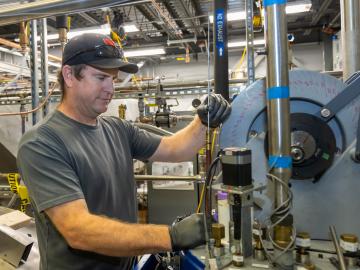Filter News
Area of Research
News Type
News Topics
- (-) 3-D Printing/Advanced Manufacturing (4)
- (-) Bioenergy (2)
- (-) Computer Science (7)
- (-) Physics (6)
- (-) Transportation (7)
- Advanced Reactors (1)
- Artificial Intelligence (3)
- Big Data (4)
- Biology (3)
- Biomedical (2)
- Biotechnology (1)
- Buildings (4)
- Chemical Sciences (1)
- Clean Water (4)
- Climate Change (7)
- Composites (3)
- Critical Materials (3)
- Cybersecurity (2)
- Decarbonization (4)
- Energy Storage (5)
- Environment (10)
- Fusion (4)
- Grid (1)
- High-Performance Computing (2)
- Isotopes (1)
- ITER (1)
- Machine Learning (2)
- Materials (2)
- Materials Science (10)
- Mercury (2)
- Microscopy (3)
- Molten Salt (3)
- Nanotechnology (6)
- National Security (2)
- Neutron Science (6)
- Nuclear Energy (7)
- Polymers (4)
- Quantum Science (1)
- Security (4)
- Simulation (2)
- Space Exploration (1)
- Sustainable Energy (3)
Media Contacts

Associate Technician Sean Hollander is the keeper of the Fundamental Neutron Physics Beamline, which is operated by the Physics Division at the Spallation Neutron Source at ORNL, where scientists use neutrons to study all manner of matter.

Alyssa Carrell started her science career studying the tallest inhabitants in the forest, but today is focused on some of its smallest — the microbial organisms that play an outsized role in plant health.

Canan Karakaya, a R&D Staff member in the Chemical Process Scale-Up group at ORNL, was inspired to become a chemical engineer after she experienced a magical transformation that turned ammonia gas into ammonium nitrate, turning a liquid into white flakes gently floating through the air.

A team of researchers at ORNL demonstrated that a light-duty passenger electric vehicle can be wirelessly charged at 100-kW with 96% efficiency using polyphase electromagnetic coupling coils with rotating magnetic fields.

Electric vehicles can drive longer distances if their lithium-ion batteries deliver more energy in a lighter package. A prime weight-loss candidate is the current collector, a component that often adds 10% to the weight of a battery cell without contributing energy.

Thought leaders from across the maritime community came together at Oak Ridge National Laboratory to explore the emerging new energy landscape for the maritime transportation system during the Ninth Annual Maritime Risk Symposium.

Leah Broussard, a physicist at the Department of Energy’s Oak Ridge National Laboratory, has so much fun exploring the neutron that she alternates between calling it her “laboratory” and “playground” for understanding the universe. “The neutron is special,” she said of the sub...

Self-driving cars promise to keep traffic moving smoothly and reduce fuel usage, but proving those advantages has been a challenge with so few connected and automated vehicles, or CAVs, currently on the road.
Physicists turned to the “doubly magic” tin isotope Sn-132, colliding it with a target at Oak Ridge National Laboratory to assess its properties as it lost a neutron to become Sn-131.

If you ask the staff and researchers at the Department of Energy’s Oak Ridge National Laboratory how they were first referred to the lab, you will get an extremely varied list of responses. Some may have come here as student interns, some grew up in the area and knew the lab by ...




